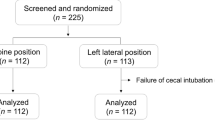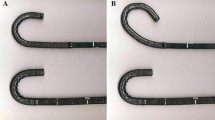Abstract
Background
There are many factors involved in a difficult colonoscopy. Our hypothesis is that colonic intubation is more difficult in thin patients. We consider it beneficial to know a priori who would be in need of specialized equipment or maneuvers for a successful colonoscopy.
Methods
Over two years, 435 consecutive patients who underwent elective colonoscopy by one surgeon were included in this prospective study. Patients who underwent prior colectomy, who had cancer other than that of the cecum, or who had had an emergent endoscopy were excluded from the study. The time it took to insert the colonoscope from the anus to the cecum was recorded and rounded to the nearest minute. For statistical analysis, we considered gender, age, body mass index (BMI), abdominal girth, diagnosis, presence or absence of prior pelvic surgery, need for external compression, and quality of the bowel preparation. The Mann-Whitney test was used to compare the median time of intubation between males and females.
Results
There was no statistically significant correlation between the BMI, abdominal girth, presence or absence of prior abdominal or pelvic surgery, and the length of insertion of the endoscope. Statistical significance was reached between the male and female. The median time to insert the colonoscope in the males was 7 min (mean = 8.14 min), while in females it was 10 min (mean = 10.6 min).
Conclusions
Females had a significantly longer time of insertion of the colonoscope compared to males. Neither abdominal girth nor body mass seems to reflect the volume of the peritoneal cavity. It seems possible that there is a content-container mismatch in thin female patients. We suggest repeating the study using other anthropometric measurements to calculate the intraperitoneal volume. This may help select the patients who would benefit from a deeper sedation or more specialized equipment.




Similar content being viewed by others
References
Anderson JC, Gonzalez JD, Messina CR, Pollack BJ (2000) Factors that predict incomplete colonoscopy: thinner is not always better. Am J Gastroenterol 95: 2784–2787
Chak A, Cooper GS, Blades EW, Canto M, Sivak MV (1996) Prospective assessment of colonoscopic intubation skills in trainees. Gastrointest Endosc 44: 54–57
Church JM (1994) Complete colonoscopy: How often? And if not? Why not? Am J Gastroenterol 89: 556–556
Cirocco WC, Rusin LC (1995) Factors that predict incomplete colonoscopy. Dis Colon Rectum 38: 964–968
Horiuchi A, Nakayama Y, Kajiyama M, Fujii H, Tanaka N (2004) Usefulness of a small-caliber, variable-stiffness colonoscope as a backup in patients with difficult or incomplete colonoscopy. Am J Gastroenterol 99: 1936–1940
Ness RM, Gottlieb K, Rex DK, Lehman GA (1996) Difficult sigmoid colon intubation: guide wire exchange technique. Gastrointest Endosc 44: 99–101
Rex DK (2002) Speeding up cecal intubation: Its role in the efficiency of colonoscopy delivery. Am J Gastroenterol 97: 6–8
Rex DK, Goodwine BW (2002) Method of colonoscopy in 42 consecutive patients presenting after prior incomplete colonoscopy. Am J Gastroenterol 97: 1148–1151
Saifuddin T, Trivedi M, King PD, Madsen R, Marshall JB (2000) Usefulness of a pediatric colonoscope for colonoscopy in adults. Gastrointest Endosc 51: 314–317
Saunders BP, Fukumoto M, Halligan S, Jobling C, Moussa ME, Bartram CI, Williams CB (1996) Why is colonoscopy more difficult in women? Gastrointest Endosc 43: 124–126
Waye JD, Bashkoff E (1991) Total colonoscopy: Is it always possible? Gastrointest Endosc 37: 152–154
Acknowledgments
The authors thank the surgical teams of Mitchell County Regional Health Center and Mercy Hospital New Hampton for their invaluable help throughout the study.
Author information
Authors and Affiliations
Corresponding author
Rights and permissions
About this article
Cite this article
Arcovedo, R., Larsen, C. & Reyes, H.S. Patient factors associated with a faster insertion of the colonoscope. Surg Endosc 21, 885–888 (2007). https://doi.org/10.1007/s00464-006-9116-5
Received:
Accepted:
Published:
Issue Date:
DOI: https://doi.org/10.1007/s00464-006-9116-5




